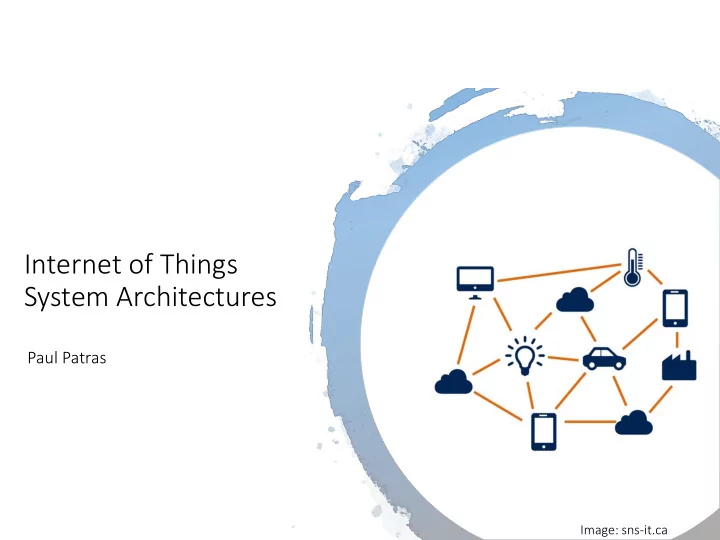

Internet of Things System Architectures Paul Patras Image: sns-it.ca
• Thousands of new applications spanning numerous domains. • Each comes with its own requirements; combining these leads to complex (difficult to manage) and often proprietary systems. • Defining a unified architecture is challenging and interoperability problematic if too many The IoT standards to chose from. • Documentation scattered and often difficult Architectural to navigate. • Efforts to define common frameworks landscape • ITU-T, 3GPP, ETSI, IETF • EC (via collaborative projects), • Industry consortium (e.g. Open Connectivity Foundation), • Big players (e.g. Cisco). • We will not cover everything, but focus on the key principles these architectural patterns share and examine some examples.
Key considerations What application domains should be covered? Where to place the “intelligence”? What networking structure should be employed? How to modularize systems, so as to manage complexity and enable programmability? What about costs and scalability?
Stakeholders slowly converging At a high level, the shared view looks like this Applications (different scales) Platform (API, protocols, data processing, device management) Security & Infrastructure/Networking Fabric Privacy (connectivity, storage) Physical world (sensors, actuators)
• Enabling software/app developers to build applications without having to understand the specifics of a device – Platform as a Service (PaaS) • Better sharing and strict partitioning of Immediate network and computing resources (slicing); taking away from service providers the burden of building and managing a advantages network – Infrastructure/Network as a Service (IaaS/Naas) • Allowing IoT device manufacturers to focus strictly on improving their performance, power consumption, etc. – expose only well- defined interfaces to software platforms.
The challenging part: Security • Hardware isolation (eFuse, ARM TrustZone) • Middleware (Intel MPX- Memory Protection Extensions) • Network isolation (VPN, SDN) • Software isolation (Sandboxing) End-to-end security not straightforward – encryption remains the only option, but sometimes expensive (computing power, communication overheads)
What happens in practice? Source: Cisco
Cloud computing dominated the networked systems landscape until recently • End-devices merely information gatherers Cloud vs • All intelligence in the cloud (relational DBs, analytics, web interfaces, control Fog vs functions) As the number of devices grows, Edge applications diversify and generate more data, this will not scale • Routing and storage costs • Signalling overheads • Latency inappropriate for real-time apps
Example: Smart metering Source: iwireless-solutions.com • Simple sensing devices; data relayed over cellular; processing by multiple entities in the cloud
Fog computing • Pushing some of the effort closer to the device, i.e. to access networks/gateways. • This includes data aggregation, compression, (partial) processing; making localised decisions. • IoT device • Not required to be extremely smart, i.e. unique address and ability to communication directly with the cloud • No substantial storage • Battery powered (lifetime)
Roles of gateways 1. Data filtering and processing (e.g., aggregation of summaries, compression, etc.) 2. Protocol translation and interfacing between different connectivity technologies 3. Security (e.g., data encryption, firewalling) 4. Data flow multiplexing, packet routing Sc Scala labil ilit ity proble lem: as the number of devices grows, so will the number of gateways that are required
Example: Home automation K. Mandula, R. Parupalli, C. A. S. Murty, E. Magesh and R. Lunagariya, "Mobile based home automation using Internet of Things(IoT)," ICCICCT, Kumaracoil, 2015
Example: Fitness tracking systems The user’s mobile phone acting as gateway H. Fereidooni, J. Classen, T. Spink, P. Patras, M. Miettinen, A.-R. Sadeghi, M. Hollick, M. Conti, "Breaking Fitness Records without Moving: Reverse Engineering and Spoofing Fitbit", Proc. RAID, Atlanta, GA, USA, Sept. 2017.
Edge computing (process as much as possible where data is collected) • Pushing processing power, communication capabilities, intelligence down at device level • Emerging applications range from autonomous vehicles, to VR glasses, to earbuds. • Do as much processing as required on the device, transmit only what is relevant long term or summaries • Low latency and decentralised decisions • Less signalling and communication overhead • Personalised experience
Example: Deep Learning at the Edge Har ardware Sup upport: Low-power chips specialised in computationally intensive tasks (IBM TrueNorth, Movidius, Huawei Kirin) Sof oftw tware: lightweight inference frameworks optimised for constrained devices (mobile TensorFlow, Apple CoreML, DeepSense) Dedi edicated NN ar architectures: Model compression (SqueezeNet, MobileNet), point-wise group convolution (ShuffleNet), model pruning (NestDNN).
Ultimately it is about performance Source: pubnub.com
Standards (I) • IEEE, 3GPP, IETF, and several alliances standardising the ‘language’ devices speak among each another / with gateways or cloud services. • IEEE (the Institute of Electrical and Electronics Engineers) mostly dealing with definition of protocols for access networks • Targeting the ISM bands with 802.15.4 (used by Zigbee) and ‘ WiFi ’ extensions for low power wide area networking, i.e. 802.11ah (HaLow)
Standards (II) • 3GPP (3 rd Generation Partnership Project) focuses on specifying cellular network architectures and protocols (GSM, 3G, 4G-LTE, etc.) • Developing standards for cellular communications tailored to IoT applications • LTE-M - compatible with existing LTE networks, easy to roll out, limited to max 1Mb/s speeds • NB-IoT - different band, lower capacity (200kb/s), different modulation, but no need for gateways.
Standards (III) • IETF (Internet Engineering Task Force) focusing on specifying protocols for • Routing (6LoWPAN, Routing Over Low- power and Lossy networks - ROLL) • End to end communications (TCP/IP, HTTP, CoAP, MQTT) • Security (DNSSEC, Datagram Transport Layer Security - DTLS) • Software updating (SUIT – specific to IoT) • Language independent formats (JSON)
Standards (IV) • Industry alliances • Bluetooth (personal area networks, application profiles) • ZigBee (on top of IEEE 802.15.4, inexpensive consumer/industrial) • LoRaWAN (low-power long range) • Other (NIST – encryption, ISO – IoT reference architecture, ITU – recommendations, reference models)
The complete picture
The complete picture
Recommend
More recommend